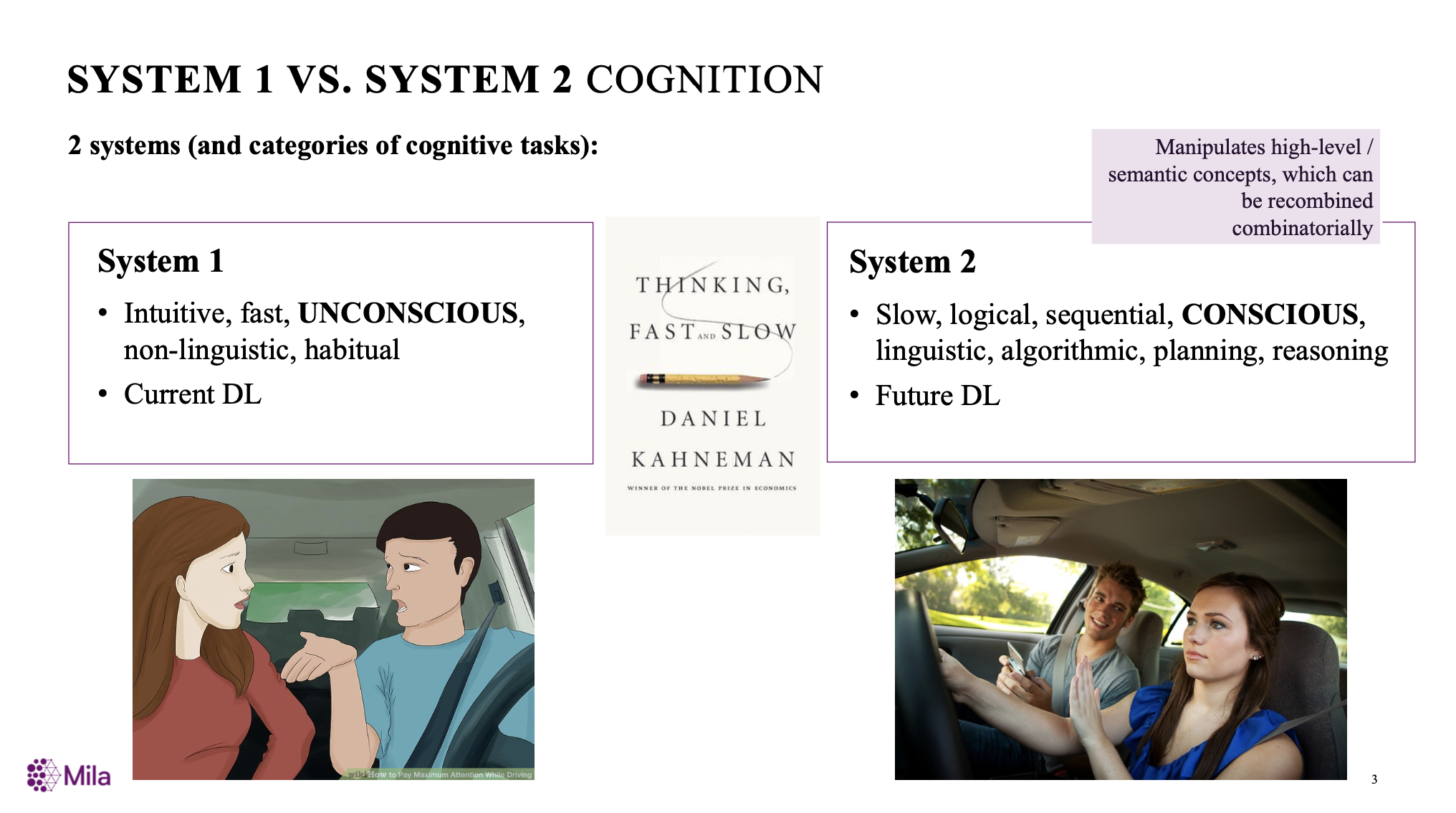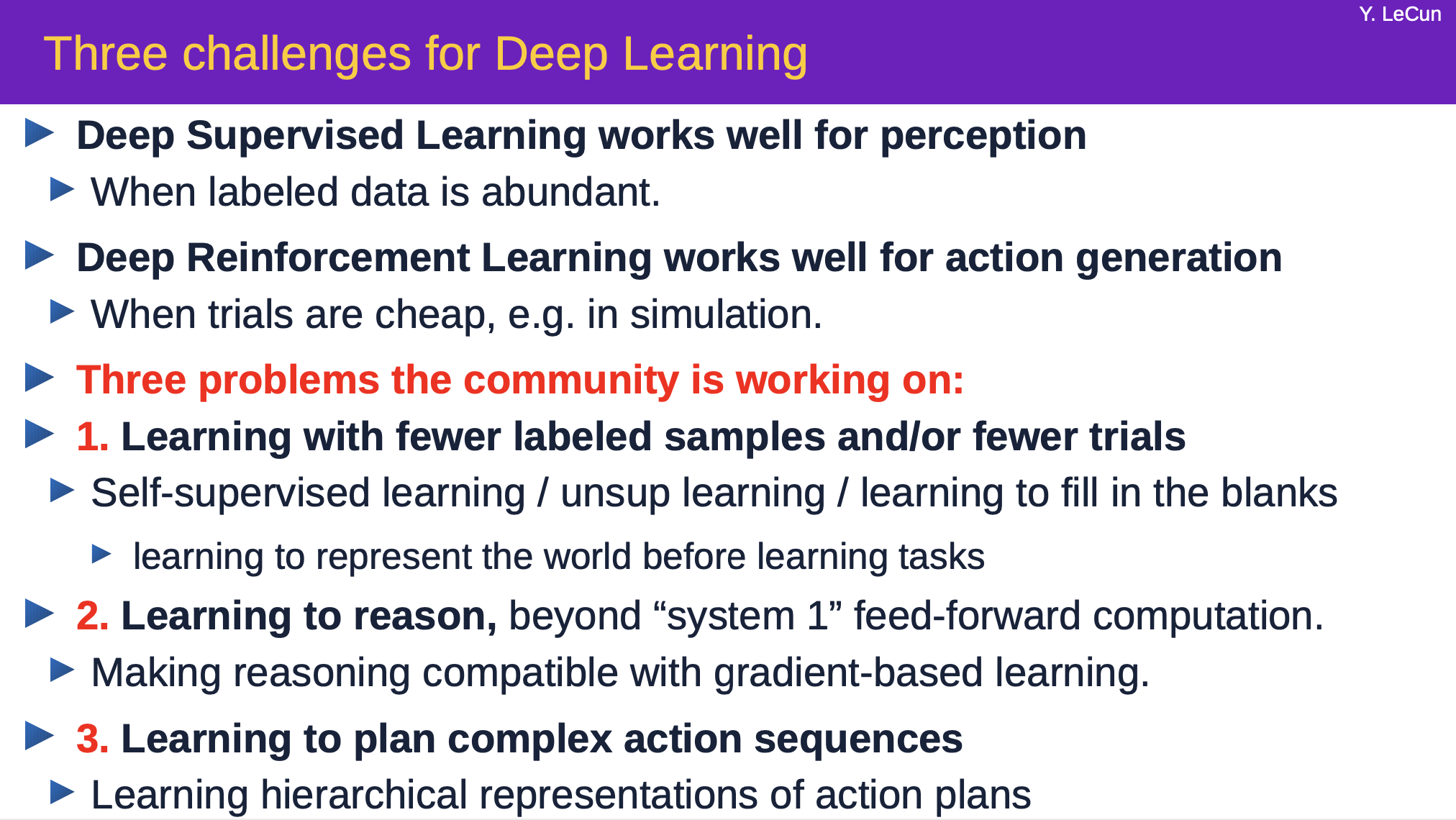Recent Papers including Neural Symbolic Reasoning, Logical Reasoning, Visual Reasoning, natural language reasoning and any other topics connecting deep learning and reasoning.
[1] Yoshua Bengio,From System 1 Deep Learning to System 2 Deep Learning [pdf] [video]
[2] Yann Lecun, Self-Supervised Learning [pdf]
[3] Petar Veličković Graph Representation Learning for Algorithmic Reasoning [pdf]
[1] Saxton, David, et al. Analysing mathematical reasoning abilities of neural models. arXiv preprint arXiv:1904.01557 (2019).[pdf]
[2] Ortega, Pedro A., et al. Meta-learning of sequential strategies. arXiv preprint arXiv:1905.03030 (2019).[pdf]
[3] Lample, Guillaume, and François Charton. Deep learning for symbolic mathematics. arXiv preprint arXiv:1912.01412 (2019).[pdf]
[4] Zhuo, Tao, and Mohan Kankanhalli. Solving Raven's Progressive Matrices with Neural Networks. arXiv preprint arXiv:2002.01646 (2020).[pdf]
[5] Zheng, Kecheng, Zheng-Jun Zha, and Wei Wei. Abstract Reasoning with Distracting Features. Advances in Neural Information Processing Systems. 2019. [pdf]
[6] van Steenkiste, Sjoerd, et al. Are Disentangled Representations Helpful for Abstract Visual Reasoning?. Advances in Neural Information Processing Systems. 2019. [pdf]
[7] Dong, Honghua, et al. Neural logic machines. arXiv preprint arXiv:1904.11694 (2019). [pdf]
[8] Zhang, Chi, et al. Learning perceptual inference by contrasting. Advances in Neural Information Processing Systems. 2019.[pdf]
[9] Santoro, Adam, et al. Measuring abstract reasoning in neural networks. International Conference on Machine Learning. 2018.[pdf]
[10] Wang, Po-Wei, et al. SATNet: Bridging deep learning and logical reasoning using a differentiable satisfiability solver. arXiv preprint arXiv:1905.12149 (2019).
[11] Manhaeve, Robin, et al. Deepproblog: Neural probabilistic logic programming. Advances in Neural Information Processing Systems. 2018.[pdf]
[13] van Steenkiste, Sjoerd, et al. Are Disentangled Representations Helpful for Abstract Visual Reasoning?. Advances in Neural Information Processing Systems. 2019. [pdf]
[14] Dai, Wang-Zhou, et al. Bridging machine learning and logical reasoning by abductive learning. Advances in Neural Information Processing Systems. 2019. [pdf] [code]
[1] Santoro, Adam, et al. Measuring abstract reasoning in neural networks. International Conference on Machine Learning. 2018.[pdf]
[2] Zhang, Chi, et al. Raven: A dataset for relational and analogical visual reasoning. Proceedings of the IEEE Conference on Computer Vision and Pattern Recognition. 2019.[pdf]
[3] Zheng, Kecheng, Zheng-Jun Zha, and Wei Wei. Abstract Reasoning with Distracting Features. Advances in Neural Information Processing Systems. 2019.[pdf]
[4] Hill, Felix, et al. "Learning to make analogies by contrasting abstract relational structure." arXiv preprint arXiv:1902.00120 (2019).[pdf]
[5] Hu, Sheng, et al. Hierarchical Rule Induction Network for Abstract Visual Reasoning. arXiv preprint arXiv:2002.06838 (2020). [pdf]
[6] Zhang, Chi, et al. Learning perceptual inference by contrasting." Advances in Neural Information Processing Systems. 2019. [pdf]
[7] van Steenkiste, Sjoerd, et al. Are Disentangled Representations Helpful for Abstract Visual Reasoning?. Advances in Neural Information Processing Systems. 2019.[pdf]
[8] Zhuo, Tao, and Mohan Kankanhalli. Solving Raven's Progressive Matrices with Neural Networks. arXiv preprint arXiv:2002.01646 (2020). [pdf]
[9] Wang, Duo, Mateja Jamnik, and Pietro Lio. Abstract diagrammatic reasoning with multiplex graph networks. (2020). [pdf]
[10] Steenbrugge, Xander, et al. Improving generalization for abstract reasoning tasks using disentangled feature representations. arXiv preprint arXiv:1811.04784 (2018). [pdf]
[1] Han, Chi, et al. Visual Concept-Metaconcept Learning. Advances in Neural Information Processing Systems. 2019. [pdf]
[2] Mao, Jiayuan, et al. Program-Guided Image Manipulators. Proceedings of the IEEE International Conference on Computer Vision. 2019.[pdf]
[3] Mao, Jiayuan, et al. The neuro-symbolic concept learner: Interpreting scenes, words, and sentences from natural supervision. arXiv preprint arXiv:1904.12584 (2019). [pdf]
[4] Tian, Yonglong, et al. Learning to infer and execute 3d shape programs. arXiv preprint arXiv:1901.02875 (2019). [pdf]
[5] Liu, Yunchao, et al. Learning to describe scenes with programs. (2018). [pdf]
[6] Yi, Kexin, et al. Neural-symbolic vqa: Disentangling reasoning from vision and language understanding. Advances in Neural Information Processing Systems. 2018. [pdf]
[1] Jaques, Miguel, Michael Burke, and Timothy Hospedales. Physics-as-inverse-graphics: Joint unsupervised learning of objects and physics from video. arXiv preprint arXiv:1905.11169 (2019). [pdf]
[2] Bakhtin, Anton, et al. Phyre: A new benchmark for physical reasoning. Advances in Neural Information Processing Systems. 2019. [pdf]
[3] Ye Y, Gandhi D, Gupta A, et al. Object-centric Forward Modeling for Model Predictive Control[J]. arXiv preprint arXiv:1910.03568, 2019. [pdf]
[4] Veerapaneni R, Co-Reyes J D, Chang M, et al. Entity Abstraction in Visual Model-Based Reinforcement Learning[J]. arXiv preprint arXiv:1910.12827, 2019.[pdf]
[5] Janner M, Levine S, Freeman W T, et al. Reasoning about physical interactions with object-oriented prediction and planning[J]. arXiv preprint arXiv:1812.10972, 2018.[pdf]
[6] Kossen J, Stelzner K, Hussing M, et al. Structured Object-Aware Physics Prediction for Video Modeling and Planning[J]. arXiv preprint arXiv:1910.02425, 2019. [pdf]
[7] Watters N, Matthey L, Bosnjak M, et al. Cobra: Data-efficient model-based rl through unsupervised object discovery and curiosity-driven exploration[J]. arXiv preprint arXiv:1905.09275, 2019.[pdf]
[8] Li Y, He H, Wu J, et al. Learning Compositional Koopman Operators for Model-Based Control[J]. arXiv preprint arXiv:1910.08264, 2019.[pdf]
[9] Kulkarni T D, Gupta A, Ionescu C, et al. Unsupervised learning of object keypoints for perception and control[C]//Advances in Neural Information Processing Systems. 2019: 10723-10733. [pdf]
[10] Kipf T, van der Pol E, Welling M. Contrastive Learning of Structured World Models[J]. arXiv preprint arXiv:1911.12247, 2019. [pdf]
[11] Chang M B, Ullman T, Torralba A, et al. A compositional object-based approach to learning physical dynamics[J]. arXiv preprint arXiv:1612.00341, 2016. [pdf]
[12] Sanchez-Gonzalez A, Godwin J, Pfaff T, et al. Learning to Simulate Complex Physics with Graph Networks[J]. arXiv preprint arXiv:2002.09405, 2020.[pdf]
[13] Battaglia P, Pascanu R, Lai M, et al. Interaction networks for learning about objects, relations and physics[C]//Advances in neural information processing systems. 2016: 4502-4510. [pdf]
[14] Watters N, Zoran D, Weber T, et al. Visual interaction networks: Learning a physics simulator from video[C]//Advances in neural information processing systems. 2017: 4539-4547. [pdf]
[15] Cranmer M, Greydanus S, Hoyer S, et al. Lagrangian Neural Networks[J]. arXiv preprint arXiv:2003.04630, 2020. [pdf]
[16] Sanchez-Gonzalez A, Heess N, Springenberg J T, et al. Graph networks as learnable physics engines for inference and control[J]. arXiv preprint arXiv:1806.01242, 2018. [pdf]
[17] Li Y, Wu J, Tedrake R, et al. Learning particle dynamics for manipulating rigid bodies, deformable objects, and fluids[J]. arXiv preprint arXiv:1810.01566, 2018.[pdf]
[1] Schlag, Imanol, and Jürgen Schmidhuber. Learning to reason with third order tensor products. Advances in neural information processing systems. 2018.[pdf]
[1] Jacobs R A, Jordan M I, Nowlan S J, et al. Adaptive mixtures of local experts[J]. Neural computation, 1991, 3(1): 79-87. [pdf]
[2] Ramezani M, Marble K, Trang H, et al. Joint sparse representation of brain activity patterns in multi-task fMRI data[J]. IEEE Transactions on Medical Imaging, 2014, 34(1): 2-12.
[3] Sternberg S. Modular processes in mind and brain[J]. Cognitive neuropsychology, 2011, 28(3-4): 156-208.
[4] Ronco E, Gollee H, Gawthrop P J. Modular neural network and self-decomposition[J]. Connection Science (special issue: COMBINING NEURAL NETS).(To appear), 1996. [pdf]
[5] Andreas J, Rohrbach M, Darrell T, et al. Neural module networks[C]//Proceedings of the IEEE Conference on Computer Vision and Pattern Recognition. 2016: 39-48. [pdf]
[6] Parascandolo G, Kilbertus N, Rojas-Carulla M, et al. Learning independent causal mechanisms[J]. arXiv preprint arXiv:1712.00961, 2017. [pdf]
[7] Rosenbaum C, Klinger T, Riemer M. Routing networks: Adaptive selection of non-linear functions for multi-task learning[J]. arXiv preprint arXiv:1711.01239, 2017. [pdf]
[8] Fernando C, Banarse D, Blundell C, et al. Pathnet: Evolution channels gradient descent in super neural networks[J]. arXiv preprint arXiv:1701.08734, 2017. [pdf]
[9] Shazeer N, Mirhoseini A, Maziarz K, et al. Outrageously large neural networks: The sparsely-gated mixture-of-experts layer[J]. arXiv preprint arXiv:1701.06538, 2017. [pdf]
[10] Kirsch L, Kunze J, Barber D. Modular networks: Learning to decompose neural computation[C]//Advances in Neural Information Processing Systems. 2018: 2408-2418. [pdf]
[11] Rosenbaum C, Cases I, Riemer M, et al. Routing networks and the challenges of modular and compositional computation[J]. arXiv preprint arXiv:1904.12774, 2019. [pdf]
[12] Goyal A, Lamb A, Hoffmann J, et al. Recurrent independent mechanisms[J]. arXiv preprint arXiv:1909.10893, 2019. [pdf]
[13] Goyal A, Sodhani S, Binas J, et al. Reinforcement Learning with Competitive Ensembles of Information-Constrained Primitives[J]. arXiv preprint arXiv:1906.10667, 2019. [pdf]
[14] Yang R, Xu H, Wu Y, et al. Multi-Task Reinforcement Learning with Soft Modularization[J]. arXiv preprint arXiv:2003.13661, 2020. [pdf]
[15] Peng X B, Chang M, Zhang G, et al. Mcp: Learning composable hierarchical control with multiplicative compositional policies[C]//Advances in Neural Information Processing Systems. 2019: 3681-3692. [pdf]
[16] Hu, Ronghang, et al. Learning to reason: End-to-end module networks for visual question answering. Proceedings of the IEEE International Conference on Computer Vision. 2017. [pdf]
[17] Devin, Coline, et al. Learning modular neural network policies for multi-task and multi-robot transfer. 2017 IEEE International Conference on Robotics and Automation (ICRA). IEEE, 2017. [pdf]
[18] Alet, Ferran, Tomás Lozano-Pérez, and Leslie P. Kaelbling. Modular meta-learning. arXiv preprint arXiv:1806.10166 (2018). [pdf]
[19] Chitnis, Rohan, Leslie Pack Kaelbling, and Tomás Lozano-Pérez. Learning quickly to plan quickly using modular meta-learning. 2019 International Conference on Robotics and Automation (ICRA). IEEE, 2019.[pdf]
[20] Alet, Ferran, et al. Modular meta-learning in abstract graph networks for combinatorial generalization. arXiv preprint arXiv:1812.07768 (2018).[pdf]
[21] Chen, Yutian, et al. Modular meta-learning with shrinkage arXiv preprint arXiv:1909.05557 (2019). [pdf]
[22] Alet, Ferran, et al. Neural Relational Inference with Fast Modular Meta-learning. Advances in Neural Information Processing Systems. 2019. [pdf]
[23] Andreas, Jacob, Dan Klein, and Sergey Levine. Modular multitask reinforcement learning with policy sketches. Proceedings of the 34th International Conference on Machine Learning-Volume 70. JMLR. org, 2017. [pdf]
[24] Bahdanau D, Murty S, Noukhovitch M, et al. Systematic generalization: what is required and can it be learned?[J]. arXiv preprint arXiv:1811.12889, 2018. [pdf]
[25] Chang M B, Gupta A, Levine S, et al. Automatically composing representation transformations as a means for generalization[J]. arXiv preprint arXiv:1807.04640, 2018.[pdf]
[26] Meunier D, Lambiotte R, Bullmore E T. Modular and hierarchically modular organization of brain networks[J]. Frontiers in neuroscience, 2010, 4: 200.
[27] Sporns O, Betzel R F. Modular brain networks[J]. Annual review of psychology, 2016, 67: 613-640.
[28] Clune J, Mouret J B, Lipson H. The evolutionary origins of modularity[J]. Proceedings of the Royal Society b: Biological sciences, 2013, 280(1755): 20122863.[pdf]
[1] Johnson, Justin, et al. Clevr: A diagnostic dataset for compositional language and elementary visual reasoning. Proceedings of the IEEE Conference on Computer Vision and Pattern Recognition. 2017. [pdf]
[2] Zellers, Rowan, et al. From recognition to cognition: Visual commonsense reasoning. Proceedings of the IEEE Conference on Computer Vision and Pattern Recognition. 2019.[pdf]
[3] Zhang, Wenhe, et al. Machine Number Sense: A Dataset of Visual Arithmetic Problems for Abstract and Relational Reasoning. Pythagoras 100.300 (1818).[pdf]
[4] Santoro, Adam, et al. Measuring abstract reasoning in neural networks. International Conference on Machine Learning. 2018.[pdf]
[5] Zhang, Chi, et al. Raven: A dataset for relational and analogical visual reasoning. Proceedings of the IEEE Conference on Computer Vision and Pattern Recognition. 2019.[pdf]
[6] Bakhtin, Anton, et al. Phyre: A new benchmark for physical reasoning. Advances in Neural Information Processing Systems. 2019. [pdf]
[7] Baradel, Fabien, et al. COPHY: Counterfactual Learning of Physical Dynamics. arXiv preprint arXiv:1909.12000 (2019). [pdf]

